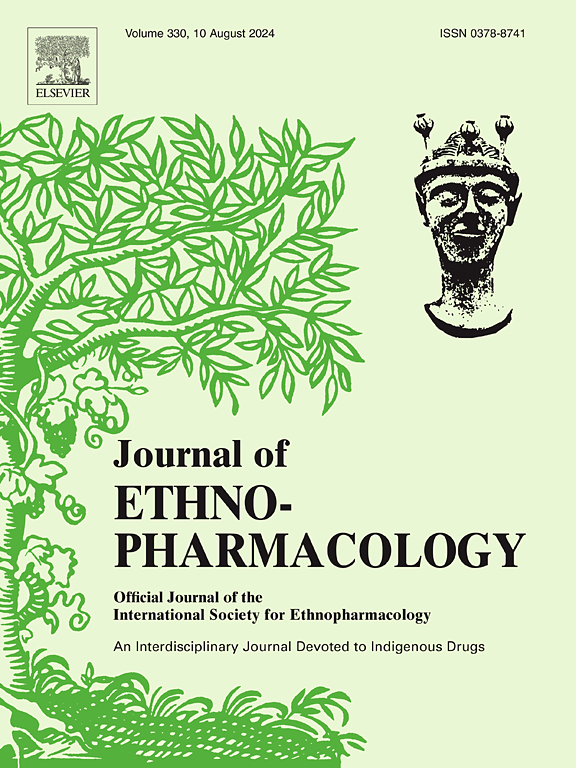鼻渊通汤通过NF-кB通路调节抑制炎症细胞粘附改善慢性鼻窦炎
IF 4.8
2区 医学
Q1 CHEMISTRY, MEDICINAL
引用次数: 0
摘要
鼻渊通汤(BYT)是一种中药制剂,多年来一直用于治疗慢性鼻窦炎(CRS),并取得了良好的临床效果。然而,其治疗CRS的潜在机制仍有待充分阐明。研究目的探讨BYT改善CRS的分子机制,为CRS治疗研究提供新的视角。材料与方法对接受手术治疗的CRS患者进行临床研究,并进行术后治疗和观察。采用H&;E染色和鼻内镜检查CRS的病理改变。采用流式细胞术和ELISA法检测CRS患者外周血炎症细胞和细胞因子水平。通过细胞活力、细胞周期和凋亡测定来评估BYT的细胞毒性作用。采用异种黏附法和transwell法观察BYT对炎症细胞对内皮细胞的粘附和侵袭的影响。采用流式细胞术分析细胞粘附分子(CAMs)在HUVECs上的表达。采用Western blot和免疫荧光染色法分析BYT对NF-κB信号通路的影响。采用UPLC-HRMS测定BYT的化学成分,并采用网络药理学分析预测NF-κB通路的潜在靶点。结果BYT治疗能有效缓解鼻窦黏膜水肿,显著降低术后复发率。H&;E染色显示CRS患者鼻窦黏膜有明显的炎症细胞浸润。流式细胞术和ELISA结果显示,BYT治疗降低了外周血嗜酸性粒细胞水平(中位数下降16.21%)和细胞因子水平。细胞粘附和transwell实验表明,BYT抑制了U937细胞对TNF-α-诱导的huvec的粘附和侵袭。此外,BYT可以抵消TNF-α-诱导的内皮细胞CAMs的上调。Western blot和免疫荧光分析证实,BYT降低了NF-κB相关蛋白的表达,阻碍了NF-κB的核易位。网络药理学分析和成分鉴定进一步支持其化合物协同调节NF-κB信号的功能。结论byt通过NF-кB通路调节炎症细胞黏附、浸润鼻腔粘膜,提高CRS的临床疗效。这些发现为BYT在CRS治疗中的临床应用提供了坚实的基础,并提示阻断炎症细胞粘附是一种潜在的新方法。本文章由计算机程序翻译,如有差异,请以英文原文为准。

Biyuantong decoction improves chronic rhinosinusitis by inhibiting inflammatory cell adhesion via NF-кB pathway modulation
Ethnopharmacological relevance
Biyuantong decoction (BYT), a traditional Chinese medicinal formulation, has been used for years to treat chronic rhinosinusitis (CRS) with good clinical results. However, the underlying mechanisms of its treatment for CRS remain to be fully elucidated.
Study aim
This research investigates the molecular mechanism by which BYT ameliorates CRS and provide new perspectives for CRS treatment research.
Materials and methods
Clinical research is conducted on CRS patients who underwent surgery, and post-operative treatments and observations were performed. The pathological alterations of CRS were inspected by H&E staining and nasal endoscopy. Flow cytometry and ELISA were employed to measure the levels of inflammatory cells and cytokines in the peripheral blood of CRS patients. The cytotoxic impacts of BYT were assessed by cell viability, cell cycle and apoptosis assays. The effects of BYT on the adhesion and invasion of inflammatory cells to endothelial cells were evaluated by hetero-adhesion and transwell assay. Flow cytometry was employed to analyze the expression of cell adhesion molecules (CAMs) on HUVECs. The effects of BYT on NF-κB signaling pathway was analyzed by Western blot and immunofluorescence staining. The chemical components of BYT was determined by UPLC-HRMS, and network pharmacology analysis was adopted to predict potential targets in the NF-κB pathway.
Results
Clinical samples demonstrated that BYT treatment could effectively alleviate sinus mucosal edema and significantly decreased the recurrence rate after surgery. H&E staining disclosed obvious inflammatory cell infiltration in the sinus mucosa of CRS patients. Flow cytometry and ELISA results indicated that BYT treatment reduced the levels of eosinophils (median decrease 16.21 %) and cytokines in peripheral blood. Cell adhesion and transwell assays manifested that BYT inhibited the adhesion and invasion of U937 cells to TNF-α-induced HUVECs. Moreover, BYT counteracted the TNF-α-induced upregulation of CAMs on endothelial cells. Western blot and immunofluorescence analyses confirmed that BYT reduced the expression of NF-κB-related proteins and hindered the nuclear translocation of NF-κB. Network pharmacology analysis and component identification of BYT further supported the function of its compounds in synergistically modulating NF-κB signaling.
Conclusion
BYT enhances the clinical efficacy of CRS by suppressing inflammatory cell adhesion and infiltration into the nasal mucosa via NF-кB pathway regulation. These findings provide a robust foundation for the clinical application of BYT in CRS treatment and suggest interrupting inflammatory cell adhesion as a potential new approach.
求助全文
通过发布文献求助,成功后即可免费获取论文全文。
去求助
来源期刊

Journal of ethnopharmacology
医学-全科医学与补充医学
CiteScore
10.30
自引率
5.60%
发文量
967
审稿时长
77 days
期刊介绍:
The Journal of Ethnopharmacology is dedicated to the exchange of information and understandings about people''s use of plants, fungi, animals, microorganisms and minerals and their biological and pharmacological effects based on the principles established through international conventions. Early people confronted with illness and disease, discovered a wealth of useful therapeutic agents in the plant and animal kingdoms. The empirical knowledge of these medicinal substances and their toxic potential was passed on by oral tradition and sometimes recorded in herbals and other texts on materia medica. Many valuable drugs of today (e.g., atropine, ephedrine, tubocurarine, digoxin, reserpine) came into use through the study of indigenous remedies. Chemists continue to use plant-derived drugs (e.g., morphine, taxol, physostigmine, quinidine, emetine) as prototypes in their attempts to develop more effective and less toxic medicinals.
 求助内容:
求助内容: 应助结果提醒方式:
应助结果提醒方式:


